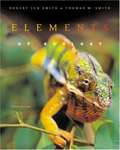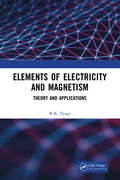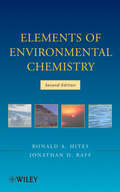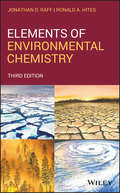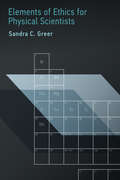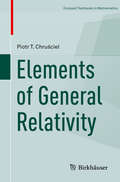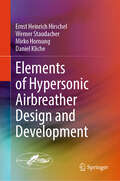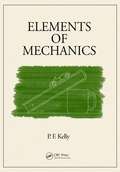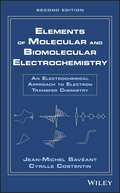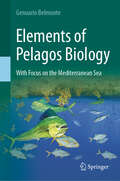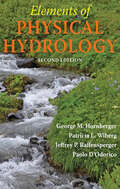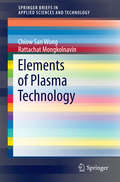- Table View
- List View
Elements of Cosmology
by Jayant V. NarlikarThe physical aspects of cosmology, including primordial nucleosynthesis, the astroparticle physics of inflation, and the current ideas on structure formation are discussed.
Elements of Crustal Geomechanics
by François Henri CornetThis key textbook considers the mechanics of geomaterials at a wide range of scales, both in time and space. It provides a detailed introduction to the study of crustal geomechanics, focusing specifically on the seismogenic crust. The author demonstrates how continuum mechanics principles can provide efficient solutions to geomechanics problems at various scales, taking into account the multiphase characteristics of the geomaterials as well as discontinuities such as fractures and faults. Field and laboratory observations are combined with basic mathematical theory to build solutions with known levels of uncertainty. Particular consideration is given to the use of microseismicity. Case studies are provided, and practical results from numerical modelling are used to illustrate the applicability and limitations of current theories. Accessible explanations of mathematical formulations, convenient summaries of the key equations, and exercises make this a valuable reference for students and researchers in geomechanics, geophysics, structural geology and engineering.
Elements of Ecology 5th Edition
by Robert Leo Smith Thomas M. SmithWith a modular organization and a beautiful four color art program, the fourth edition of this leading text for non-majors continues to provide a clear presentation of the principles of ecology and illustrate their relation to today's environmental issues. Far-reaching in its coverage, the fourth edition provides the most up-to-date information with a new chapter on global warming and deforestation. It also focuses on ecology as a science, providing the basic background information needed to show the relevance of studying environmental problems on a global scale.
Elements of Electricity and Magnetism: Theory and Applications
by R.K. TyagiThis book covers the theory, concepts, and applications associated with electricity and magnetism. It discusses various fundamental aspects including Coulomb’s Law, electric potential, capacitors, dielectrics, and paramagnetism. Aimed at undergraduate students with an elementary knowledge of mathematical analysis, it also includes solved problems at the end of each chapter for better understanding.The subject matter of this book also includes: The Biot-Savart Law RL Circuit Electromagnetic Wave Equation Displacement Current Equipotential Surfaces Print edition not for sale in South Asia (India, Sri Lanka, Nepal, Bangladesh, Pakistan or Bhutan)
Elements of Environmental Chemistry
by Ronald A. Hites Jonathan D. RaffFrom Reviews of the First Edition:"This splendid, at times humorous, and reasonably priced little book has much to commend it to undergraduate chemists and to other science students." -J. G. Farmer, University of Edinburgh"Complex environmental issues are presented in simple terms to help readers grasp the basics and solve relevant problems." -J. Albaiges, University of Barcelona "The main strength of the book lies in its explanations of the calculation of quantitative relationships. Each chapter includes 15-20 problems that are carefully chosen from a didactic standpoint, for which the reader can find solutions at the end." -D. Lenoir, Institute for Ecological Chemistry"What drew me to the first edition was the style - the no nonsense, down-to-earth explanations and the practical examples that litter the text. The dry humor expressed in the footnotes is great and reminds me of other classic texts." -T. Clough, Lincoln UniversityA practical approach to environmental chemistryProviding readers with the fundamentals of environmental chemistry and a toolbox for putting them into practice, Elements of Environmental Chemistry, Second Edition is a concise, accessible, and hands-on volume designed for students and professionals working in the chemical and environmental sciences.Tutorial in style, this book fully incorporates real-world problems and extensive end-of-chapter problem sets to immerse the reader in the field. Chapters cover mass balance, chemical kinetics, carbon dioxide equilibria, pesticide structures and much more. Extensively revised, updated, and expanded, this Second Edition includes new chapters on atmospheric chemistry, climate change, and polychlorinated biphenyls and dioxins, and brominated flame retardants. In addition, new practice problems and a helpful tutorial on organic chemistry names and structures have been added to improve both the scope and accessibility of the book.
Elements of Environmental Chemistry
by Ronald A. Hites Jonathan D. RaffA practical approach to environmental chemistry, Elements of Environmental Chemistry, 3rd Edition provides readers with the fundamentals of environmental chemistry and a toolbox for putting them into practice. This is a concise, accessible, and hands-on volume designed for students and professionals working in the chemical and environmental sciences. The 3rd Edition has been completely revised and rearranged. The first chapter on tool skills has been expanded to include thermodynamic considerations and measurement issues. The former chapter on the partitioning of organic compounds has been expanded to cover the fates of organic compounds, with an emphasis on developing the reader's "chemical intuition" for predicting a chemical's fate based on structure. The material on lead, mercury, pesticides, PCBs, dioxins, and flame retardants has been expanded and combined into the last chapter and supplemented with more references to the literature. The problem sets have been extended and now include over 130 problems, some of which can be solved using Excel.
Elements of Ethics for Physical Scientists
by Sandra C. GreerA guide to the everyday decisions about right and wrong faced by physical scientists and research engineers. This book offers the first comprehensive guide to ethics for physical scientists and engineers who conduct research. Written by a distinguished professor of chemistry and chemical engineering, the book focuses on the everyday decisions about right and wrong faced by scientists as they do research, interact with other people, and work within society. The goal is to nurture readers' ethical intelligence so that they know an ethical issue when they see one, and to give them a way to think about ethical problems. After introductions to the philosophy of ethics and the philosophy of science, the book discusses research integrity, with a unique emphasis on how scientists make mistakes and how they can avoid them. It goes on to cover personal interactions among scientists, including authorship, collaborators, predecessors, reviewers, grantees, mentors, and whistle-blowers. It considers underrepresented groups in science as an ethical issue that matters not only to those groups but also to the development of science, and it examines human participants and animal subjects. Finally, the book examines scientifically relevant social issues, including public policy, weapons research, conflicts of interest, and intellectual property. Each chapter ends with discussion questions and case studies to encourage debate and further exploration of topics. The book can be used in classes and seminars in research ethics and will be an essential reference for scientists in academia, government, and industry.
Elements of Friction Theory and Nanotribology
by Enrico Gnecco Ernst MeyerCombining the classical theories of contact mechanics and lubrication with the study of friction on the nanometer range, this multi-scale book for researchers and students alike guides the reader deftly through the mechanisms governing friction processes, based on state-of-the-art models and experimental results. The first book in the field to incorporate recent research on nanotribology with classical theories of contact mechanics, this unique text explores atomic scale scratches, non-contact friction and fishing of molecular nanowires as observed in the lab. Beginning with simple key concepts, the reader is guided through progressively more complex topics, such as contact of self-affine surfaces and nanomanipulation, in a consistent style, encompassing both macroscopic and atomistic descriptions of friction, and using unified notations to enable use by physicists and engineers across the scientific community.
Elements of General Relativity (Compact Textbooks in Mathematics)
by Piotr T. ChruścielThis book provides an introduction to the mathematics and physics of general relativity, its basic physical concepts, its observational implications, and the new insights obtained into the nature of space-time and the structure of the universe. It introduces some of the most striking aspects of Einstein's theory of gravitation: black holes, gravitational waves, stellar models, and cosmology. It contains a self-contained introduction to tensor calculus and Riemannian geometry, using in parallel the language of modern differential geometry and the coordinate notation, more familiar to physicists. The author has strived to achieve mathematical rigour, with all notions given careful mathematical meaning, while trying to maintain the formalism to the minimum fit-for-purpose. Familiarity with special relativity is assumed. The overall aim is to convey some of the main physical and geometrical properties of Einstein's theory of gravitation, providing a solid entry point to further studies of the mathematics and physics of Einstein equations.
Elements of Heat Transfer
by Ethirajan RathakrishnanWritten for chemical, mechanical, and aerospace engineering students taking courses on heat and mass transfer, this textbook presents the basics and proceeds to the required theory and its application aspects. Major topics covered include conduction, convection, radiation, boiling, heat exchangers, and mass transfer and are explained in a detailed,
Elements of Hypersonic Airbreather Design and Development
by Ernst Heinrich Hirschel Werner Staudacher Mirko Hornung Daniel KlicheThis book sketches key design, development, and engineering issues. To think up an airbreathing hypersonic aircraft is one thing; to design, develop, and produce it is another one. Airframe-propulsion integration plays a central role, with six integration types identified. Most demanding is that of a large aircraft with both lift and propulsion located at its lower side—an approach exemplified early by the US National Aerospace Plane. Topics treated are the flight environment, design sensitivities, fuel considerations, aerothermodynamics, scramjet propulsion, airframe-propulsion integration, structural and materials issues, and aerothermoelasticity. Persistent challenges include laminar-turbulent transition and joint modelling. Capabilities and shortcomings of experimental, computational, and in-flight simulation are considered. The second wave of mathematization—culminating in the concept of the virtual product—has fundamentally transformed flight vehicle design, enabling integrated, high-fidelity simulation across disciplines. In this book, students, design engineers, and technical managers will find ample insight and practical knowledge regarding hypersonic airbreather design.
Elements of Mathematical Methods for Physics
by Francis E. MensahElements of Mathematical Methods for Physics provides students with an approachable and innovative introduction to key concepts of mathematical physics, accompanied by clear and concise explanations, relevant real-world examples and problems that help them to master the fundamentals of mathematical physics. The topics are presented at a basic level, for students lacking a prior mathematical background.This book is designed to be covered in two semesters, presenting 18 chapters on topics varying from differential equations, matrix algebra and tensor analysis to Fourier transform, including special functions and dynamical systems.Upper-level undergraduate and graduate students of physics and engineering as well as professionals will gain a better grip of the basics and a deeper insight into and appreciation for mathematical methods for physics.Key Features:• Reviews and presents the basic math skills needed at the undergraduate level.• Chapters accompanied by examples and end-of-chapter problems to enhance understanding.• Introduces dynamical systems and includes a chapter on Hilbert Space
Elements of Mechanics
by P.F. KellyThe first volume in a three-part series, Elements of Mechanics provides a rigorous calculus-based introduction to classical physics. It considers diverse phenomena in a systematic manner and emphasises the development of consistent and coherent models guided by symmetry considerations and the application of general principles. Modern developments c
Elements of Modern X-ray Physics
by Des Mcmorrow Jens Als-NielsenEagerly awaited, this second edition of a best-selling text comprehensively describes from a modern perspective the basics of x-ray physics as well as the completely new opportunities offered by synchrotron radiation. Written by internationally acclaimed authors, the style of the book is to develop the basic physical principles without obscuring them with excessive mathematics.The second edition differs substantially from the first edition, with over 30% new material, including: A new chapter on non-crystalline diffraction - designed to appeal to the large community who study the structure of liquids, glasses, and most importantly polymers and bio-moleculesA new chapter on x-ray imaging - developed in close cooperation with many of the leading experts in the fieldTwo new chapters covering non-crystalline diffraction and imagingMany important changes to various sections in the book have been made with a view to improving the expositionFour-colour representation throughout the text to clarify key conceptsExtensive problems after each chapter There is also supplementary book material for this title available online (http://booksupport.wiley.com).Praise for the previous edition:"The publication of Jens Als-Nielsen and Des McMorrow's Elements of Modern X-ray Physics is a defining moment in the field of synchrotron radiation... a welcome addition to the bookshelves of synchrotron-radiation professionals and students alike.... The text is now my personal choice for teaching x-ray physics..." - Physics Today, 2002
Elements of Molecular and Biomolecular Electrochemistry: An Electrochemical Approach to Electron Transfer Chemistry (Baker Lecture Ser. #13)
by Jean-Michel Savéant Cyrille CostentinWritten by two of the world's leading authorities in the field of electrochemistry, this book comprehensively addresses workhorse electrochemical reactions that serve as the basis of modern research for alternative energy solutions. Provides an accessible and readable summary on the use of electrochemical techniques and the applications of electrochemical concepts to functional molecular-level systems Includes a new chapter on proton coupled electron transfer, a completely revamped chapter on molecular catalysis of electrochemical reactions, and added sections throughout the book Bridges a gap and strengthens the relationship between electrochemists, molecular and biomolecular chemists—showing a variety of functions that may be obtained by multi-component systems designed using the paradigms of both chemistries
Elements of Neurogeometry
by Jean PetitotThis book describes several mathematical models of the primary visual cortex, referring them to a vast ensemble of experimental data and putting forward an original geometrical model for its functional architecture, that is, the highly specific organization of its neural connections. The book spells out the geometrical algorithms implemented by this functional architecture, or put another way, the "neurogeometry" immanent in visual perception. Focusing on the neural origins of our spatial representations, it demonstrates three things: firstly, the way the visual neurons filter the optical signal is closely related to a wavelet analysis; secondly, the contact structure of the 1-jets of the curves in the plane (the retinal plane here) is implemented by the cortical functional architecture; and lastly, the visual algorithms for integrating contours from what may be rather incomplete sensory data can be modelled by the sub-Riemannian geometry associated with this contact structure. As such, it provides readers with the first systematic interpretation of a number of important neurophysiological observations in a well-defined mathematical framework. The book's neuromathematical exploration appeals to graduate students and researchers in integrative-functional-cognitive neuroscience with a good mathematical background, as well as those in applied mathematics with an interest in neurophysiology.
Elements of Pelagos Biology: With Focus on the Mediterranean Sea
by Genuario BelmonteOceans cover more than 70% of the Earth's surface, with an average depth of approximately 3,800 meters. Humanity is largely excluded from this vast world of saltwater, which remains mostly unexplored and unknown. The goal of this book is to introduce readers to this unfamiliar and mysterious realm. It delves into various species and communities in great detail, emphasizing that the taxonomy, life cycles, and ecological dynamics differ significantly from what is typically taught in basic Biology and Natural Sciences courses, which often focus on terrestrial or freshwater environments, and occasionally, benthic habitats. The pelagic lifestyle, by contrast, is rarely emphasized in Marine Biology textbooks. This book aims to shift that perspective, highlighting the pelagic way of life for marine organisms. As a teaching method, species, geographical locations, and key topics are repeatedly revisited throughout the text to enhance their visibility and reinforce their understanding in the minds of students.
Elements of Physical Hydrology
by George M. Hornberger Patricia L. Wiberg Jeffrey P. Raffensperger Paolo D'OdoricoThe most cogent textbook ever produced on the topic, this revised and expanded edition will be welcomed by students and professionals alike.Among the many diverse aspects of environmental science, none is more critical to the future of society and nature than water. Understanding the role of water on Earth and making good decisions regarding water conservation and hydrological hazards depends on learning the fundamentals of physical hydrology. This textbook, now in an expanded second edition, provides the clearest opportunity for students to absorb those fundamentals. Written at an introductory level, Elements of Physical Hydrology covers virtually every aspect of this subject, including:• The hydrological cycle• Water budgets at catchment to global scales • Spatial and temporal aspects of precipitation• Evapotranspiration• Fluid dynamics and the Bernoulli equation• Laminar and turbulent flows• Open channel flow • Flood movement through reservoirs and channels • Flood frequency analysis• Groundwater flow• Aquifer characterization• Land subsidence• Soil moisture dynamics• Flow in the unsaturated zone• Hydrologic controls on vegetation • Biotic controls on hydrological processes• Runoff generation from surface and subsurface sources• Catchment models• The water-food-energy nexus• The globalization of water• Impacts of changing climateLayering one topic upon the next, Elements of Physical Hydrology succeeds in moving from simple, easy-to-grasp explanations through equations and models in a manner that will leave students new to the topic eager to apply their knowledge. Professionals in related disciplines will also find this book ideal for self-study. Thoughtfully illustrated, carefully written, and covering a broad spectrum of topics, this classic text clarifies a subject that is often misunderstood and oversimplified.
Elements of Plasma Technology
by Chiow San Wong Rattachat MongkolnavinThis book presents some fundamental aspects of plasma technologythat are important for beginners interested to start research in the area ofplasma technology. These include the properties of plasma, methods of plasmageneration and basic plasma diagnostic techniques. It also discusses severallow cost plasma devices, including pulsed plasma sources such as plasma focus,pulsed capillary discharge, vacuum spark and exploding wire; as well as lowtemperature plasmas such as glow discharge and dielectric barrier dischargewhich the authors believe may have potential applications in industry. Thetreatments are experimental rather than theoretical, although some theoreticalbackground is provided where appropriate. The principles of operation of thesedevices are also reviewed and discussed.
Elements of Quantum Computation and Quantum Communication
by Anirban PathakWhile there are many available textbooks on quantum information theory, most are either too technical for beginners or not complete enough. Filling the gap, this book gives a clear, self-contained introduction to quantum computation and communication. Exploring recent developments and open questions in the field, it prepares readers for further study and helps them understand more advanced texts and journal papers. Along with thought-provoking cartoons and brief biographies of key players in the field, each chapter includes examples, references, exercises, and problems with detailed solutions.
Elements of Radio Frequency Energy Harvesting and Wireless Power Transfer Systems
by Yahia M.M. Antar Taimoor Khan NasimuddinThis book focuses on elementary concepts of both radio frequency energy harvesting (RFEH) and wireless power transfer (WPT), and highlights their fundamental requirements followed by recent advancements. It provides a systematic overview of the key components required for RFEH and WPT applications and also comprehensively introduces the pioneering research advancements achieved to date. The state-of-the-art circuit design topologies for the two different applications are presented mainly in terms of antenna operating frequencies, polarization characteristics, efficient matching network circuits, rectifier topologies, and overall rectenna systems. The book serves as a single point of reference for practicing engineers and researchers searching for potential sources and elements involved in the RFEH system as well as in the WPT system, and need rapid training and design guidelines in the following areas: • Different sensing elements used in RFEH and WPT • Inclusions of mathematical expressions and design problems • Illustration of some design examples and performance enhancement techniques
Elements of Slow-Neutron Scattering
by Carpenter J. M. Loong C. K.Providing a comprehensive and up-to-date introduction to the theory and applications of slow-neutron scattering, this detailed book equips readers with the fundamental principles of neutron studies, including the background and evolving development of neutron sources, facility design, neutron scattering instrumentation and techniques, and applications in materials phenomena. Drawing on the authors' extensive experience in this field, this text explores the implications of slow-neutron research in greater depth and breadth than ever before in an accessible yet rigorous manner suitable for both students and researchers in the fields of physics, biology, and materials engineering. Through pedagogical examples and in-depth discussion, readers will be able to grasp the full scope of the field of neutron scattering, from theoretical background through to practical, scientific applications.
Elements of Statistical Thermodynamics: Second Edition (Dover Books on Chemistry)
by Leonard K. NashThis concise, elementary treatment illustrates the ways in which an atomic-molecular perspective yields new insights and powers operative in the realms of macroscopic thermodynamics. Starting with an analysis of some very simple microcanonical ensembles, it proceeds to the Boltzmann distribution law and a systematic exploration of the proper formulation, evaluation, and application of partition functions. The concepts of equilibrium and entropy thus acquire new significance, and readers discover how thermodynamic parameters may be calculated from spectroscopic data.Encompassing virtually all of the forms of statistical mechanics customary to undergraduate physical chemistry books, this brief text requires prior acquaintance with only the rudiments of the calculus and a few of the simplest propositions of classical thermodynamics. Appropriate for introductory college chemistry courses, it further lends itself to use as a supplementary text for independent study by more advanced students.
Elements of Structural Dynamics: A New Perspective
by Debasish Roy G. V. RaoStructural dynamics is a subset of structural analysis which covers the behavior of structures subjected to dynamic loading. The subject has seen rapid growth and also change in how the basic concepts can be interpreted. For instance, the classical notions of discretizing the operator of a dynamic structural model have given way to a set-theoretic, function-space based framework, which is more conducive to implementation with a computer. This modern perspective, as adopted in this book, is also helpful in putting together the various tools and ideas in a more integrated style. Elements of Structural Dynamics: A New Perspective is devoted to covering the basic concepts in linear structural dynamics, whilst emphasizing their mathematical moorings and the associated computational aspects that make their implementation in software possible. Key features: Employs a novel ‘top down’ approach to structural dynamics. Contains an insightful treatment of the computational aspects, including the finite element method, that translate into numerical solutions of the dynamic equations of motion. Consistently touches upon the modern mathematical basis for the theories and approximations involved. Elements of Structural Dynamics: A New Perspective is a holistic treatise on structural dynamics and is an ideal textbook for senior undergraduate and graduate students in Mechanical, Aerospace and Civil engineering departments. This book also forms a useful reference for researchers and engineers in industry.
Elements of Surprise: Our Mental Limits and the Satisfactions of Plot
by Vera TobinWhy do some surprises delight—the endings of Agatha Christie novels, films like The Sixth Sense, the flash awareness that Pip’s benefactor is not (and never was!) Miss Havisham? Writing at the intersection of cognitive science and narrative pleasure, Vera Tobin explains how our brains conspire with stories to produce those revelatory plots that define a “well-made surprise.” By tracing the prevalence of surprise endings in both literary fiction and popular literature and showing how they exploit our mental limits, Tobin upends two common beliefs. The first is cognitive science’s tendency to consider biases a form of moral weakness and failure. The second is certain critics’ presumption that surprise endings are mere shallow gimmicks. The latter is simply not true, and the former tells at best half the story. Tobin shows that building a good plot twist is a complex art that reflects a sophisticated understanding of the human mind. Reading classic, popular, and obscure literature alongside the latest research in cognitive science, Tobin argues that a good surprise works by taking advantage of our mental limits. Elements of Surprise describes how cognitive biases, mental shortcuts, and quirks of memory conspire with stories to produce wondrous illusions, and also provides a sophisticated how-to guide for writers. In Tobin’s hands, the interactions of plot and cognition reveal the interdependencies of surprise, sympathy, and sense-making. The result is a new appreciation of the pleasures of being had.

